Ideas about Vocabulary Instruction for the Beginning Communicator
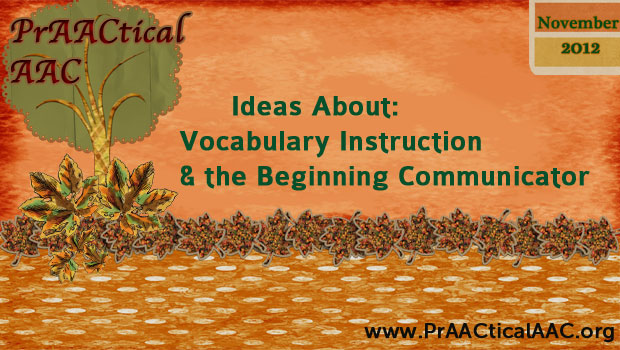
Vocabulary instruction is a topic not often discussed for beginning communicators. As we work with beginning communicators the primary focus is often vocabulary selection for communication displays. This is understandable as the beginning communicator has many needs, but that is no excuse for leaving out vocabulary instruction. Direct vocabulary instruction helps expand broader vocabulary selection options, literacy skills, and world knowledge. With that in mind, see below for vocabulary instruction philosophies, notes, and activities for the beginning communicator. Please let us know about your favorite vocabulary instruction activities.
Vocabulary Instruction for the Beginning Communicator:
5 Philosophies
- Vocabulary instruction involves a systematic TEACHING process. Add vocabulary as an activity on the daily schedule and then have a mini-schedule for the specific vocabulary instruction activities for that day. Carole introduced general steps for vocabulary instruction last week. For the beginning communicator, also apply an errorless learning paradigm. Gradually, add comprehension checks, but do not wait for ‘proof’ of comprehension because we often notice that the beginning communicator will demonstrate comprehension during ‘unexpected opportunities- or when you are least expecting it.
- Vocabulary Instruction Is for EVERYONE. There are no pre-requisite skills needed.
- Vocabulary Instruction Involves ALL modalities of Language- Remember to use activities for vocabulary instruction that incorporate reading, writing, listening, & talking.
- Vocabulary Instruction Must Incorporate Many Many Opportunities for Active Participation. In this context, active participation means multi-sensory active participation. Learners should move, feel, touch, activate, see, hear, and overall experience the vocabulary.
- Vocabulary Instruction Should be Dynamic, Interactive, & Fun. Use humor or seriousness with word presentation but consider the personalities of your learners as vocabulary instruction activities are created. Choose words within a theme that would be meaningful and interesting to learners.
5 Notes on Vocabulary Instruction for the Beginning Communicator
- Everything above applies to communicators who do not yet use language to talk about language (metalinguistic knowledge) & that is OK.
- Vocabulary is more than just words and definitions, it is robust word knowledge (antonyms, synonyms, rhyming, multiple representations, categorization, acting words out, etc). Vocabulary is way more than nouns. Have vocabulary target words represent ALL parts of speech.
- Use a Variety of Multi-Sensory Teaching Strategies (differentiate strategies based on your specific learners). Use lots of repetition with variety.
- Use a Variety of Language Facilitation Strategies (Aided Language Input, Scaffolding, Recasting, etc.).
- Presume competence and success in vocabulary instruction for ALL learners.
10 Activities of Vocabulary Instruction for the Beginning Communicator 
- Use Thematic Teaching and choose Words of the Week. Themes can be chosen based on a pre-determined curriculum from school or on a social basis (friends, playing, etc) or a holiday , etc. Just make it fun and interesting. If possible, have learners choose the Themes and/or the Words of the Week. An activity of ‘deciding’ can be an individual or group process. Have a Theme or Word of the Week choice board. The learners are deciding but you have only included options you are willing to consider. Then use the monthly calendar so everyone knows what will be ‘talked about’ each week or month.
- Read books that include words of the week. Highlight or sticky note the ‘target words’
- Use a Word Wall for Words of the Week. Have learners add pictures, objects, remnants, text, etc. that define, categorize, or semantically relate to the target words. As the word wall becomes an important part of vocabulary instruction and learners are familiar with it, add some visual markers for where different items would be placed (i.e., categories, text, etc. you can even use some creative classifications for example ugly _________ or funny _________).
- Create Word of the Week books. These can be tangible books, folders with pockets, talking power point books, talking photo albums, etc. Keep in mind to use the principles of active participation (i.e., Let learners glue, stick, record speech, type to help create the books).
- Create Word of the Week boxes. Again, keep principles of active participation in mind. Students can put items in a box, decorate the box, close the box, move the box, etc. Remember this is not a test, it is teaching so initially all items for the student to put in the box should be correct options.
- Use word art activities. Make word clouds, embed words in images, word banners, etc. Hang the creations up, Use aided language input when talking about them.
- Create some super fun ways of interacting with the words. Anything goes here- go outside and have a word SHOUT OUT. If learner is using AAC device , turn up the volume or get an amplifier. Learners love the absurd.
- Create Word Recipes. This can be done a variety of ways. Words Recipes can help a learner put together a sentence by adding ingredients (words/or word symbols) to form a sentence that has meaning that ends with eating real food. Word Recipes can also be a traditional recipe which highlights the target word in some way. For example, if the Words of the Week had a theme of ‘Friends’, the food recipe could be ‘friendship’ cookies with specific friendship words written on each cookie, or each cookie could have a single letter and when they are put together it would spell the target words. As parts of the words are ‘eaten’, model or have the learners say the new way the word sounds.
- Play Word Scavenger Hunts. Hide words around an area and then use a ‘sleuth’ costume or props to find the words. This allows for more opportunities to use language facilitation strategies around the words.
- Have an end of a theme Word Party (add ‘positive’ surprises and have a Word Party at a time other than at the end, this can be done to help teach ‘change of schedule’ or ‘surprise’ when using schedules). Word parties can have cool hats with target words, fun food (have learners choose one of the Word Recipes you have done).
Filed under: Strategy of the Month
Tagged With: beginning communicator, communication, language, language facilitation activities, teaching, vocabulary
This post was written by Robin Parker
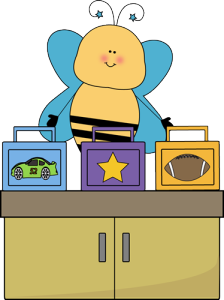

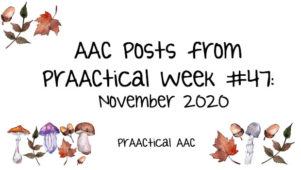
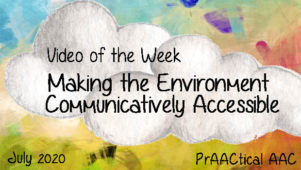
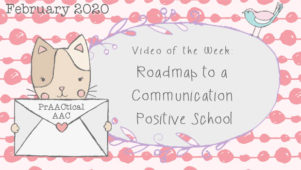
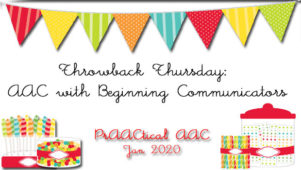
1 Comment
Love these ideas for helping to make vocabulary relevant, interesting and FUN for all students!